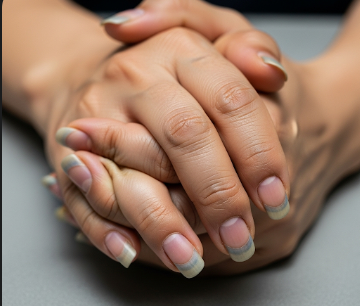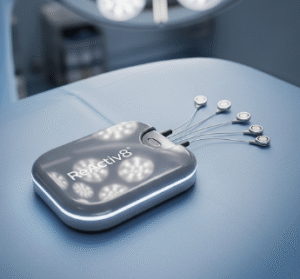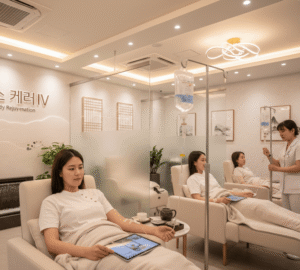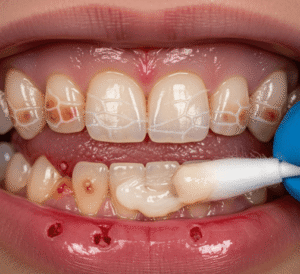Overview
Nail clubbing is a physical condition characterized by enlargement and rounding of the fingertips or toes, accompanied by changes in the shape and curvature of the nails. This condition is often a sign of underlying health problems, particularly involving the heart, lungs, or gastrointestinal system.
While nail clubbing itself is not painful, it may indicate chronic oxygen deficiency or systemic diseases. In Korea, early diagnosis through clinical evaluation and targeted investigations allows for management of underlying causes and monitoring of progression.
Key Facts
➤ Nail clubbing involves swelling of the fingertips and curved, shiny nails.
➤ It can be congenital (present from birth) or acquired due to chronic medical conditions.
➤ Commonly associated with lung, heart, liver, or gastrointestinal diseases.
➤ Nail clubbing may develop gradually over weeks or months.
➤ In Korea, management focuses on diagnosing underlying disease and monitoring progression.
What is Nail Clubbing?
Nail clubbing occurs when the soft tissue at the fingertips or toes enlarges, causing nails to become:
- Convex or curved
- Spongy or shiny
- Rounded at the tips
➔ Schamroth’s sign – when the nails of opposite fingers are placed together, the diamond-shaped window disappears in clubbing.
➔ Nail clubbing is usually bilateral but may be unilateral in rare cases.
It is considered a clinical marker rather than a disease itself, often pointing to chronic hypoxia or systemic disease.
Symptoms Related to Nail Clubbing
➤ Enlarged fingertips or toes.
➤ Nails become shiny, thickened, and curved.
➤ Soft tissue beneath the nail may feel spongy.
➤ Sometimes associated with pain or swelling if underlying inflammation exists.
➤ Gradual progression, often developing over months.
➤ May be accompanied by symptoms of underlying conditions, such as cough, shortness of breath, or fatigue.
Causes / Possible Causes
Nail clubbing is linked to various underlying disorders, including:
Pulmonary Causes
➤ Chronic lung diseases such as COPD, cystic fibrosis, or bronchiectasis.
➤ Lung cancer, particularly non-small cell carcinoma.
➤ Interstitial lung disease causing chronic hypoxia.
Cardiac Causes
➤ Congenital heart disease with cyanosis.
➤ Endocarditis or other chronic heart conditions.
➤ Heart failure leading to reduced oxygenation.
Gastrointestinal and Liver Causes
➤ Cirrhosis or chronic liver disease.
➤ Inflammatory bowel disease (IBD) such as Crohn’s disease or ulcerative colitis.
➤ Malabsorption syndromes affecting oxygen transport or nutrition.
Other Causes
➤ Hyperthyroidism or thyroid disorders.
➤ Genetic or congenital forms (rare).
➤ Idiopathic, where no underlying disease is identified.
Risk Factors
➤ Chronic lung diseases or long-term oxygen deprivation.
➤ Heart conditions, particularly cyanotic congenital heart disease.
➤ Chronic liver or gastrointestinal diseases.
➤ Family history of congenital nail clubbing.
➤ Smoking, which contributes to pulmonary and cardiovascular risks.
Complications
While nail clubbing itself is not harmful, it may indicate serious underlying conditions:
➤ Chronic hypoxia leading to organ damage.
➤ Complications related to heart, lung, or liver disease.
➤ Delayed diagnosis of lung cancer or congenital heart disease if ignored.
➤ Emotional or cosmetic concerns due to changes in appearance.
When Should I See My Doctor?
Seek medical attention if:
➤ You notice gradual enlargement of fingertips or nail curvature.
➤ Nail clubbing appears suddenly or rapidly.
➤ Associated with shortness of breath, chronic cough, or chest pain.
➤ There is family history of heart or lung disease.
➤ Over-the-counter or home measures do not explain nail changes.
Early evaluation helps detect underlying systemic diseases and prevent complications.
Care and Treatment
Lifestyle and Home Measures
➤ Quit smoking to improve lung and heart function.
➤ Maintain a healthy diet and weight to support overall health.
➤ Regular exercise and cardiovascular fitness as advised by a doctor.
➤ Monitor nails and report changes promptly.
➤ Manage underlying conditions such as chronic lung or liver disease.
Medical Treatments
➤ Treatment is directed at the underlying cause, not the nail change itself.
➤ Pulmonary diseases may require oxygen therapy, medications, or surgery.
➤ Heart conditions may need corrective surgery or medication.
➤ Gastrointestinal or liver disease requires targeted management including nutrition support.
➤ Rare cases may involve genetic counseling for congenital forms.
Preventive Measures
➤ Regular screening for chronic diseases in at-risk individuals.
➤ Early intervention for respiratory, cardiovascular, or gastrointestinal disorders.
➤ Avoid environmental or lifestyle factors that exacerbate hypoxia.
Treatment Options in Korea
Korea provides comprehensive evaluation and management for nail clubbing:
Diagnostic Services
➤ Physical examination and nail assessment.
➤ Blood tests and oxygen saturation studies.
➤ Imaging for lungs, heart, or liver (X-ray, CT scan, echocardiography).
➤ Genetic or congenital disease evaluation if indicated.
Therapies and Supportive Care
➤ Management of pulmonary conditions with modern respiratory medicine.
➤ Cardiac care including corrective surgery or medication for congenital or chronic heart disease.
➤ Gastroenterology and hepatology interventions for liver and bowel disorders.
➤ Monitoring and follow-up of nail changes as indicators of disease progression.
➤ Integration of Western medicine, Korean traditional medicine, and preventive care for holistic management.
✅ In summary: Nail clubbing is a visible change in the fingers or toes that often signals underlying lung, heart, liver, or gastrointestinal disorders. While the nail changes themselves are harmless, timely evaluation in Korea allows for diagnosis and treatment of the root causes, ensuring overall health, preventing complications, and providing both medical and cosmetic support.













